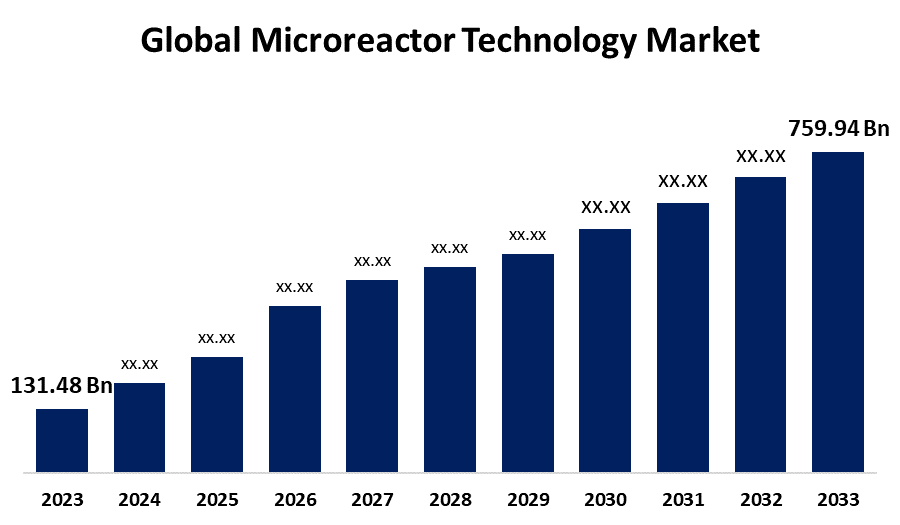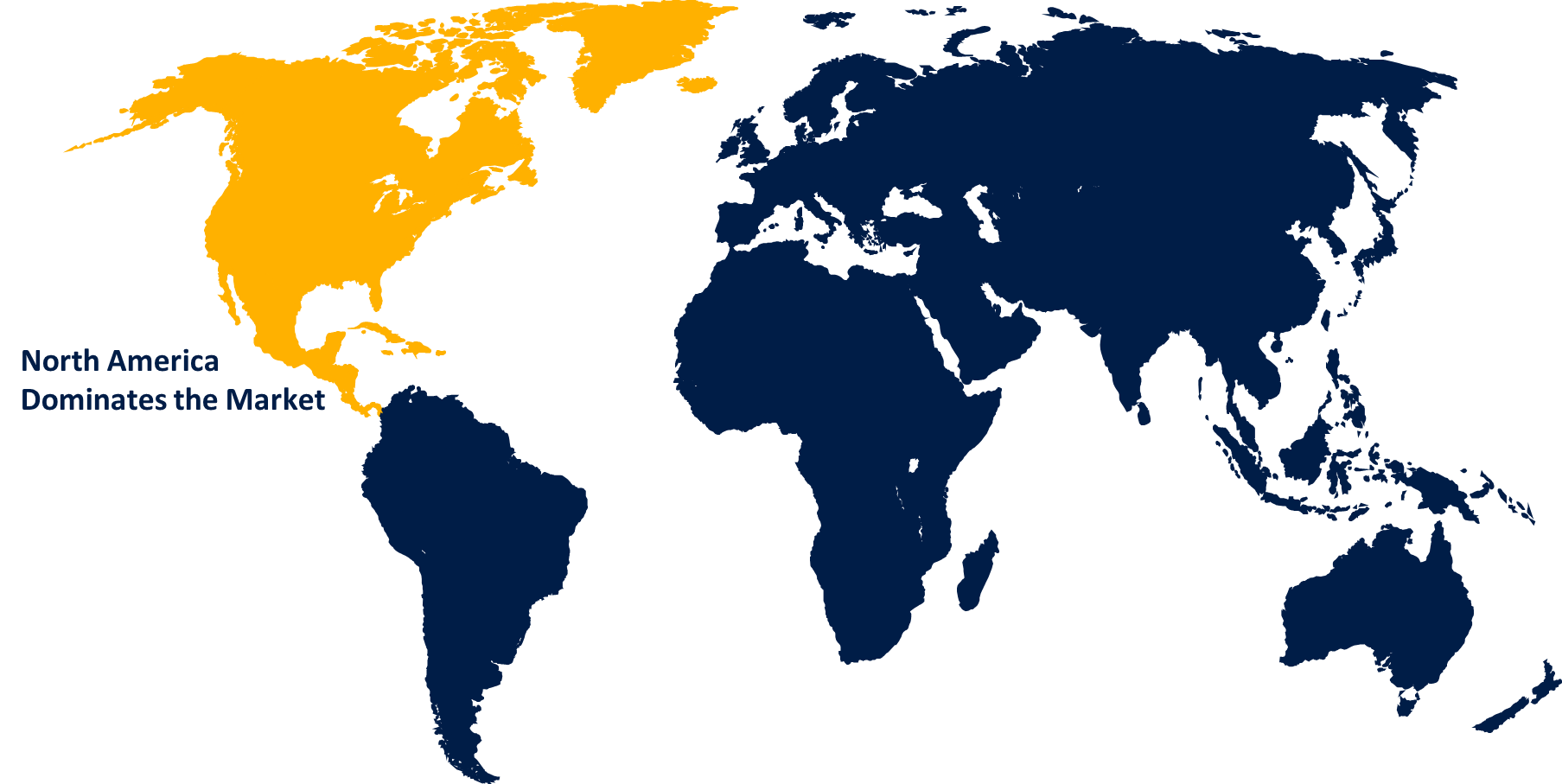Global Microreactor Technology Market Size, Share, and COVID-19 Impact Analysis, By Type (Lab Use and Production Use), By Application (Specialty Chemicals, Pharmaceuticals, and Commodity Chemicals), and By Region (North America, Europe, Asia-Pacific, Latin America, Middle East, and Africa), Analysis and Forecast 2023 - 2033
Industry: Chemicals & MaterialsGlobal Microreactor Technology Market Insights Forecasts to 2033
- The Global Microreactor Technology Market Size was Valued at USD 131.48 Billion in 2023
- The Market Size is Growing at a CAGR of 19.18% from 2023 to 2033
- The Worldwide Microreactor Technology Market Size is Expected to Reach USD 759.94 Billion by 2033
- Asia Pacific is Expected to Grow the fastest during the forecast period.

Get more details on this report -
The Global Microreactor Technology Market Size is Anticipated to Exceed USD 759.94 Billion by 2033, Growing at a CAGR of 19.18% from 2023 to 2033.
Market Overview
Microreactor technology refers to the utilization of small, modular reactors specifically engineered to execute chemical reactions on a microscale level. These reactors are typically the size of a chip or small container that allows for highly efficient chemical reactions to take place in a controlled environment, which is substantially more efficient than traditional macroscopic reactors. A smaller size results in overall small-scale heat and mass transfer rates, a much more precise ability to control reaction conditions, and significantly less overall risk of hazardous reactions. Microreactors are employed in pharmaceuticals, chemicals, and energy applications, including drug synthesis, fine chemicals, and even hydrogen generation. These microreactor systems are designed to operate under a continuous flow of reactants, in addition to all of the aforementioned performance advantages, which again improves efficiency while still allowing real-time detection and adjustments. In addition, they are energy-efficient and cost-effective, particularly when compared to other types of reactors, and they are relatively safer reactors because they “limit the amount of reactive material present at any given time.” The ability to scale is a significant advantage of microreactor technology. Multiple microreactors can be connected to increase production without the need for large facilities. This makes the technology especially appealing to industries seeking to reduce costs, waste, and environmental impact. As a result, microreactor technology is gaining popularity for sustainable and adaptable manufacturing solutions in a variety of industries.
Report Coverage
This research report categorizes the market for the global microreactor technology market based on various segments and regions forecasts revenue growth and analyzes trends in each submarket. The report analyses the key growth drivers, opportunities, and challenges influencing the global microreactor technology market. Recent market developments and competitive strategies such as expansion, product launch, and development, partnership, merger, and acquisition have been included to draw the competitive landscape in the market. The report strategically identifies and profiles the key market players and analyses their core competencies in each sub-segment of the global microreactor technology market.
Global Microreactor Technology Market Report Coverage
| Report Coverage | Details |
|---|---|
| Base Year: | 2023 |
| Market Size in 2023: | USD 131.48 Billion |
| Forecast Period: | 2023 – 2033 |
| Forecast Period CAGR 2023 – 2033 : | 19.18% |
| 023 – 2033 Value Projection: | USD 759.94 Billion |
| Historical Data for: | 2019 - 2022 |
| No. of Pages: | 225 |
| Tables, Charts & Figures: | 115 |
| Segments covered: | By Type, By Application, By Region |
| Companies covered:: | Corning, Chemtrix, Little Things Factory, AM Technology, Soken Chemical and Engineering, Ehrfeld Mikrotechnik BTS, Microinnova Engineering, Nakamura Choukou, Uniqsis, YMC, Future Chemistry, Syrris, Vapourtec, Suzhou Wenhao, Thaletec GmbH, and Others |
| Pitfalls & Challenges: | COVID-19 Empact, Challenge, Future, Growth, & Analysis |
Get more details on this report -
Driving Factors
Growing demand for sustainable and efficient manufacturing processes
The increasing need for sustainable and high-efficiency manufacturing processes in various industries, notably pharmaceuticals, specialty chemicals, and fine chemicals, is one of the core growth drivers of the microreactor technology market. Microreactors offer many advantages over batch reactors, including reduced reaction times, increased yields, and improved selectivity. Incorporating microreactor technology allows for accurate control of reaction conditions, increased energy savings, and less waste generation with substantially reduced carbon impact. As companies begin to actively look for ways to lower the carbon footprint associated with manufacturing and efficient cost production, microreactor technology will continue to grow in popularity.
Restraining Factors
Imperfect Scalability
Scaling up microreactors to meet mass production demands can be technically challenging and may not always result in cost-effective outcomes. As a result, traditional batch reactors may still be preferred in some cases, limiting the widespread implementation of microreactor technology in specific industries.
Market Segmentation
The global microreactor technology market share is classified into type and application.
- The lab use segment is expected to hold the largest share of the global microreactor technology market during the forecast period.
Based on the type, the global microreactor technology market is categorized into lab use and production use. Among these, the lab use segment is expected to hold the largest share of the global microreactor technology market during the forecast period. Microreactors find application within a lab environment for research, development, and experimentation. Microreactors are used by scientists, researchers, and chemists to analyze small, obvious chemical reactions. Lab-use microreactors also have advantages such as more precise reaction conditions, faster reaction times, and fewer reagent and waste volumes. Lab use microreactors are used in an academic, pharmaceutical company, or research institution setting for investigating new reaction pathways or pre-optimizing the reaction to scale up for production.
- The pharmaceuticals segment is expected to grow at the fastest CAGR during the forecast period.
Based on the application, the global microreactor technology market is categorized into specialty chemicals, pharmaceuticals, and commodity chemicals. Among these, the pharmaceuticals segment is expected to grow at the fastest CAGR during the forecast period. Microreactor technology is largely driven by the pharmaceutical sector. Micro-reactors are becoming prevalent in pharmaceutical manufacturing based on many advantages offered by micro-reactor technology, including improved process control, safety, as well as high-efficiency and precision for chemical reactions. The growth of micro-reactors in the pharmaceuticals field is largely due to the need for advanced drug synthesis technologies, the emergence of personalized medicine, and the demand for nano-pharmaceuticals. Micro-reactors facilitate one-step reactions and applications are accelerating production overall, which is important within pharmaceutical research and development and contributes to their market lead.
Regional Segment Analysis of the Global Microreactor Technology Market
- North America (U.S., Canada, Mexico)
- Europe (Germany, France, U.K., Italy, Spain, Rest of Europe)
- Asia-Pacific (China, Japan, India, Rest of APAC)
- South America (Brazil and the Rest of South America)
- The Middle East and Africa (UAE, South Africa, Rest of MEA)
North America is projected to hold the largest share of the global microreactor technology market over the forecast period.

Get more details on this report -
North America is projected to hold the largest share of the global microreactor technology market over the forecast period. The region's dominance can be attributed to factors such as the presence of well-established pharmaceutical and chemical industries, widespread adoption of advanced technologies, and favorable government initiatives that encourage innovation and research in these sectors. Additionally, stringent regulations governing safety and environmental concerns in industries fuel the demand for microreactor technology in this region.
Asia Pacific is expected to grow at the fastest CAGR growth of the global microreactor technology market during the forecast period. The microreactor technology market in Asia-Pacific is expected to expand at a substantial year-on-year growth. Rapid industrialization, growing foreign investments, and increasing demand to serve pharmaceutical, and chemical product manufacturing in nations like China, India as well as Japan are expected to drive growth. The interest in microreactors is growing and demand for their application may increase because human society tends towards more economization of processes with a broader implementation of integrated economy throughout the region as well as technology advances.
Competitive Analysis:
The report offers the appropriate analysis of the key organizations/companies involved within the global microreactor technology market along with a comparative evaluation primarily based on their product offering, business overviews, geographic presence, enterprise strategies, segment market share, and SWOT analysis. The report also provides an elaborative analysis focusing on the current news and developments of the companies, which includes product development, innovations, joint ventures, partnerships, mergers & acquisitions, strategic alliances, and others. This allows for the evaluation of the overall competition within the market.
List of Key Companies
- Corning
- Chemtrix
- Little Things Factory
- AM Technology
- Soken Chemical and Engineering
- Ehrfeld Mikrotechnik BTS
- Microinnova Engineering
- Nakamura Choukou
- Uniqsis
- YMC
- Future Chemistry
- Syrris
- Vapourtec
- Suzhou Wenhao
- Thaletec GmbH
- Others
Key Market Developments
- In March 2024, Prodigy Clean Energy and Des Nedhe Group signed a memorandum of understanding (MoU) to look into the potential deployment of Prodigy's microreactor Transportable Nuclear Power Plants (TNPPs) to power remote mining operations and communities across Canada.
- In February 2024, Shimadzu Corporation acquired Activated Research Company, LLC's catalytic microreactor business for gas chromatography, giving it a competitive advantage in the Green Transformation (GX) sector of gas chromatography.
Key Target Audience
- Market Players
- Investors
- End-users
- Government Authorities
- Consulting And Research Firm
- Venture capitalists
- Value-Added Resellers (VARs)
Market Segment
This study forecasts revenue at global, regional, and country levels from 2020 to 2033. Spherical Insights has segmented the global microreactor technology market based on the below-mentioned segments:
Global Microreactor Technology Market, By Type
- Lab Use
- Production Use
Global Microreactor Technology Market, By Application
- Specialty Chemicals
- Pharmaceuticals
- Commodity Chemicals
Global Microreactor Technology Market, By Regional
- North America
- US
- Canada
- Mexico
- Europe
- Germany
- UK
- France
- Italy
- Spain
- Russia
- Rest of Europe
- Asia Pacific
- China
- Japan
- India
- South Korea
- Australia
- Rest of Asia Pacific
- South America
- Brazil
- Argentina
- Rest of South America
- Middle East & Africa
- UAE
- Saudi Arabia
- Qatar
- South Africa
- Rest of the Middle East & Africa
Frequently Asked Questions (FAQ)
-
1.What is the CAGR of the global microreactor technology market over the forecast period?The Global Microreactor Technology Market Size is Expected to Grow from USD 131.48 Billion in 2023 to USD 759.94 Billion by 2033, at a CAGR of 19.18% during the forecast period 2023-2033.
-
2.Which region is expected to hold the highest share in the global microreactor technology market?North America is projected to hold the largest share of the global microreactor technology market over the forecast period.
-
3.Who are the top key players in the microreactor technology market?The top key players in the global microreactor technology market are Corning, Chemtrix, Little Things Factory, AM Technology, Soken Chemical and Engineering, Ehrfeld Mikrotechnik BTS, Microinnova Engineering, Nakamura Choukou, Uniqsis, YMC, Future Chemistry, Syrris, Vapourtec, Suzhou Wenhao, Thaletec GmbH, and Others.
Need help to buy this report?